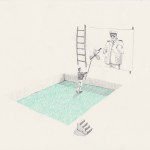I recently criticized Jerry Saltz for his group scold of contemporary painters, and today on the Vulture blog Saltz names a name, slamming Thomas Eggerer’s show at Petzel:
The second I saw Thomas Eggerer’s current large show at Petzel Gallery � the artist’s fourth here since 2004�I thought, This overrated art star is way out of gas, going through the motions.
As I lingered, looking, going from work to work and back again, things only devolved. I thought, I know this feeling. It’s that, sadly, these purposeless humdrum shows by fairly well-known artists are becoming more common. At the risk of boring you with a little description, all the paintings
are pointlessly big, physically unoriginal, and aimlessly narrative. All
are said to be priced in the $40,000-to-$100,000 range….
But, Saltz concludes, Eggerer isn’t the only one experiencing a rough patch. He proposes that the problem is endemic to many of the artists producing work for the global networks of megagalleries:
We all have bad outings. Yet the kind of bottoming-out of overpriced highly marketed artists that we see now regularly in megagalleries
is, increasingly, not confined to those spaces. It’s become systemic.
Eggerer is just another blue-chip artist who was overvalued and
overrated from the beginning. The market did what the market does with
artists like him. So did curators. That’s nothing new. But the sort of
flagrant bottoming-out that Eggerer evinces is being repeated all over
the globe, in spaces both mega and not. Artists and galleries are
sliding away from the artistic depths � confused yet confident, with
compasses broken.
I agree that when artists turn their studio practices into factories to stock megagalleries and art fairs, art suffers. Boatloads of bad art find their way into the world. But when I saw Eggerer’s show, I liked the way the paint was slapped on the canvas next to the outlined stock-photo figures. I assumed Eggerer was exploring a more Casualist approach.
Images above: Thomas Eggerer, 2013 installation views at Petzel. And here is some work from earlier exhibitions:
“Thomas Eggerer: Gesture and Territory,” Petzel, Chelsea, New York, NY. through November 9, 2013.
Related posts:
NYTimes Art in Review: Chris Ofili, Elif Uras, Thomas Eggerer (2007)



















I don't really think that Satlz's criticisms of the show are necessarily wrong, because these paintings do feel like aimless wall decoration; however, I'm getting the sense that Jerry Saltz has gotten far too salty and disenchanted with the world of new york art for his own good. Rather than writing about shows on the fringes of the market, that aren't necessarily getting the critical attention they deserve but are still trying to push boundaries and do innovative things, he choses to write about big money artists and big money galleries that are more often than not art stores rather than art temples. His approach and perspective is what's forming his opinions, not the reality of contemporary art. Just because a painting sells for 40-100 grand doesn't mean it should be written about, even if it is to deride the idea that it's worth anything near that amount. I guess I'm saying he's not working hard enough to find the gems, and instead is falling into his curmudgeon chair and being an annoying back-seat driver — commenting only on the mistakes and missteps and affronts, rather than changing his purview of the situation to find the good. The only way to fix the problem he has with the "art world" is to champion a cycling of said art world and let newer artists in to change the landscape so we can really see who of the older "overrated" crew can still shine.
After quoting a large chunk of Saltz' review, you conclude that Saltz is missing the point with his critique of Eggerer's work, since the artist – in your opinion – "was exploring a more Casualist approach." Basically you are saying that the work is not bad, because Eggerer explores tropes within painting that you prefer. Even better: Eggerer fits a category created by you.
I do not understand how your stance is critical. And it should be, as you accuse Saltz of a bad review and therefore of bad criticism.
We do not need to attack any artist whose work we dislike, but we also should avoid toothless dabbling in art writing whenever possible.
"Critical" is one of those slippery words that can mean many things, Victor. I appreciate your comments. Thanks for reading.
–Sharon
I honestly do not care who is wrong or who is right here. What I do agree with is that the current market, as it is set up by dealers and art fairs, is forcing artists to work when perhaps a month in Maui would better serve them and recharge their batteries. I have been searching for a year and a half for a young artist to write about for one of the major shelter magazines and I cannot find him/her/it. Too kitsch, too tired, too derivative. We can only hope the art world engine burns itself out and has to re calibrate, but with all the money to be made I doubt that will happen anytime soon.
Butler's initial post gently lodges a softer alternative to Saltz's harsh assessment by offering the observation that Eggerer's work seems consonant with Casualism. Witkowski, who appears to be having teething problems, construes this comment as a furtive attempt to promote a category that anyone who has read the blog would know Butler has unabashedly established and discussed. Then he accuses her of lacking a "critical stance," evidently equating a cordial response with a "toothless" one. It seems to me that Butler's approach is working: in an October 10 post, she challenged Saltz to publish specific reviews of artists he had theretofore merely scolded collectively, and he delivered. Witkowski should avoid masking witless fatuity with stridency.
The game will be played as long as we continue to watch. Do you want to see change in the art world AND art market? Do the one thing you CAN do! Target the museums — specifically those that receive ANY form of tax / gov assistance.
Demand that they actually EXPLORE and DISCOVER the art of today… instead of preserving the BIG art market as they have done steadily for the last several decades. Get politicians involved. Raise Hell.
If the museums do what they should be doing in the first place (they should be documenting / preserving beyond the BIG art market) the BIG art market will be forced to adapt… and discover.
The BIG art market needs museums for validity / credibility… so what happens when the museums start to acknowledge the masses instead of playing market politics as they have been doing? Game Changer.